How to Remove Fiberglass From a Fabric Chair
This post contains affiliate links. As an Amazon Associate, we earn from qualifying purchases.
To effectively remove fiberglass from a fabric chair, begin by wearing gloves, safety goggles, and a mask for protection. Use a heat gun to soften the fibers, and then carefully lift them with a putty knife, taking your time to avoid creating a mess. For any fibers that may cling to your skin, wash them off with soap and water, and use tape to remove any remaining particles. This guide will provide additional tips and detailed instructions for those seeking a comprehensive understanding of the process.
Essential Facts in 30 Seconds
- Wear protective gear: Use a respirator mask, goggles, and gloves to avoid fiberglass exposure.
- Soften fiberglass: Use a heat gun to make fiberglass fibers easier to lift with a putty knife.
- Ensure ventilation: Work in a well-ventilated area to prevent inhaling harmful fumes and particles.
- Remove fiberglass carefully: Take your time to minimize the release of particles while removing strands.
- Clean up thoroughly: Seal contaminated materials in bags for disposal and wash clothes separately.
Preparation and Safety Measures
Before removing fiberglass from fabric, safety is very important. Start with a good respirator mask like N95 or P100. This will keep fiberglass particles from making you sneeze or cough. Wear safety goggles to protect your eyes. Long-sleeved shirts and pants will shield your skin. Thick gloves, either rubber or leather, are also necessary. Safety gear is essential to ensure your protection during this process.
Prepare your workspace. Clear away any movable objects. This helps limit the spread of fibers. Cover nearby surfaces with dust cloths or plastic sheeting. Make sure your area has good ventilation. Turn on air filters to keep the air clean. Place warning signs around your workspace to alert others.
With these safety measures in place, you can tackle the task confidently!
Tools and Techniques for Removal
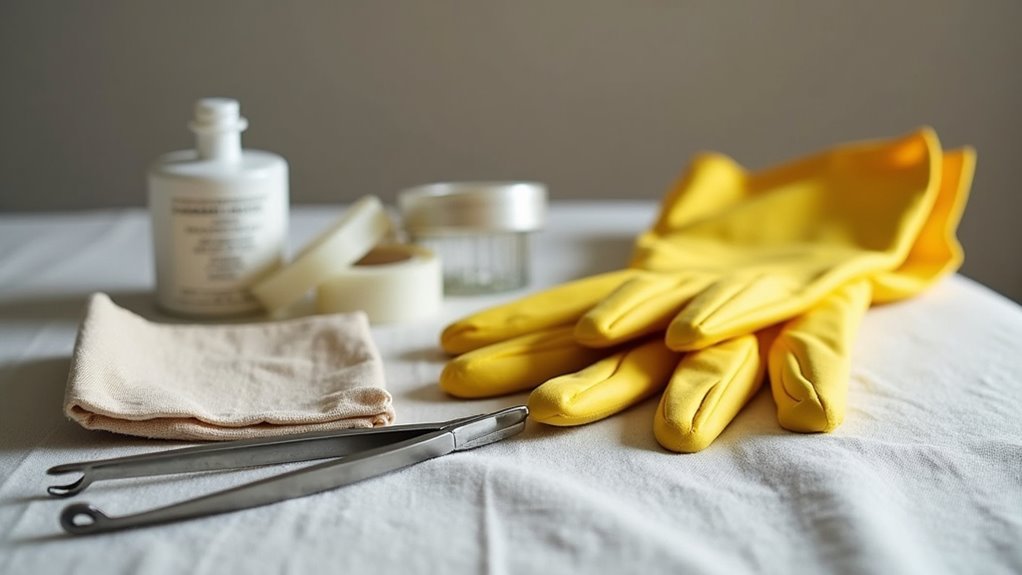
To remove fiberglass from fabric, you need the right tools and methods. Start with a heat gun. This will soften the fiberglass fibers. Use a putty knife to gently lift the fibers off, like scraping frosting from a cake. Ensure you work in a well-ventilated area to avoid inhaling any harmful fumes. For the final cleanup, take a soft brush and a microfiber cloth. These will help catch any leftover bits. With these steps, your fabric will look clean and fresh!
Heat Gun Application
Tackling fiberglass stuck in your fabric chair is easier than you think.
Start with a high-quality heat gun. Set the temperature between 300°C to 500°C. Ensure you’re in a well-ventilated area for safety. Hold the heat gun at a safe distance from the fabric to avoid burning it.
Begin by heating the edge of the fiberglass. This will soften the resin. Move the heat gun back and forth to prevent hot spots. Wear gloves to protect your hands. It’s important to remember that glass fibers can penetrate lungs, so take precautions while handling.
Gently lift the fiberglass as you heat it. Pull slowly and steadily. Patience is key here!
With these steps, you’ll get closer to a fiberglass-free chair. Celebrate your success with a high-five!
Using Putty Knives
Using a putty knife to remove fiberglass from fabric makes the job easier. Follow these simple steps for success:
- Always wear protective gloves. This keeps your hands safe.
- Make sure the area is well-ventilated. Fresh air helps.
- Carefully slide the knife under the fiberglass edge. Be gentle to avoid tears.
- Apply steady pressure. Lift the strands slowly. No need to hurry.
- If the fiberglass is stubborn, tap lightly. Be gentle to avoid damage.
With these tips, you can tackle fiberglass removal like a pro!
Final Cleanup Techniques
After removing fiberglass with a putty knife, it’s time for final cleanup.
Use a HEPA vacuum to capture those tiny fibers. A soft brush on the vacuum helps too.
Grab a microfiber cloth for any remaining bits. For better results, mix a professional cleaning solution (0.1-5%) with warm water. This makes it easier to remove stubborn fibers.
Consider steam cleaning or ultrasonic methods for deep-set fibers. Lint rollers or duct tape work well for quick fixes.
Keep the area well-ventilated and wear protective gear. You’ve done great work!
Cleaning Fiberglass From Skin and Clothing
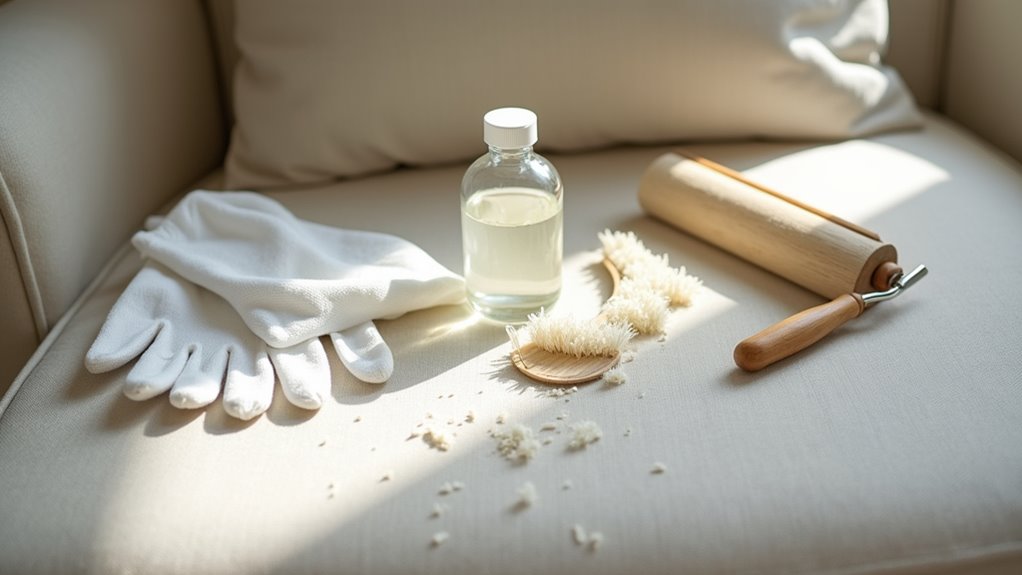
Cleaning fiberglass from your skin and clothes is easy! Start by washing any exposed skin with warm water and mild soap. This helps loosen those pesky fibers. Use a soft washcloth to wipe gently. This way, you won’t push the fibers in deeper. For any remaining fibers, use adhesive tape to pull them off.
Remember these important tips:
- Don’t rub or scratch your skin. This can cause irritation.
- Take a shower to wash away any leftover fibers.
- Watch for signs of irritation, like itching or redness.
- Seek medical help if irritation continues.
After you clean your skin, check your clothes. Shake them outside to remove fibers. Use tape to catch any that stick. Wash your clothes separately to avoid spreading fibers.
With these steps, you’ll be fiberglass-free quickly. You can do it!
Environmental Controls and Cleanup
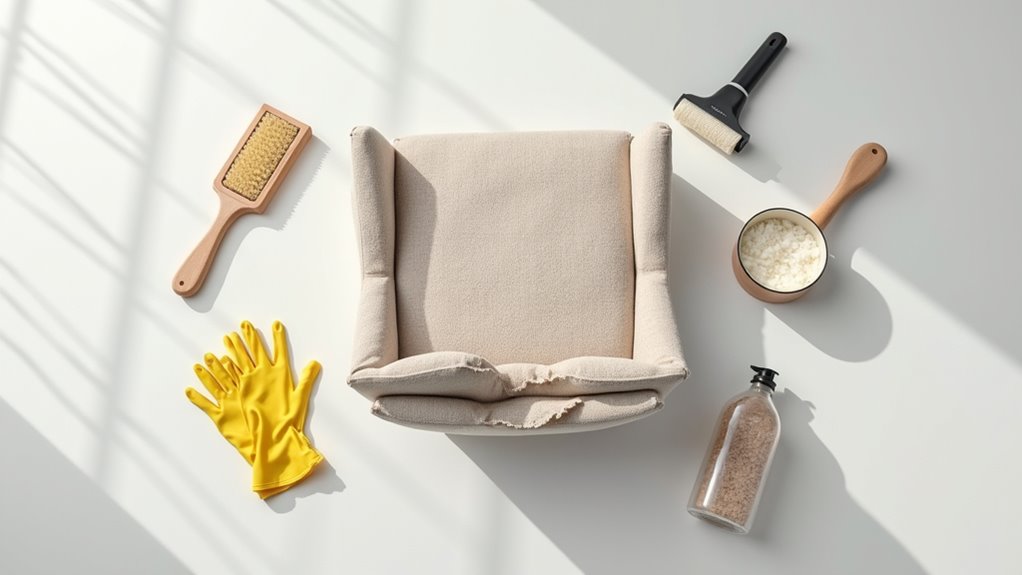
Keeping your workspace clean and safe is important when working with fiberglass.
Working outside helps. Fresh air carries away harmful fibers.
Clean your tools well after use. This stops the spread of fiberglass.
Dispose of contaminated materials properly. No one wants a surprise fiberglass mess in their garage.
Follow these steps for a safer workspace. Remember, safety first!
Outdoor Work Environment
Setting up your outdoor workspace makes a big difference for fiberglass cleanup. Evaluating the weather helps you work comfortably and safely. Here are some tips to create a great outdoor area:
- Good Ventilation: Let the air flow. This helps avoid dust buildup.
- Surface Protection: Use dust cloths. They shield nearby surfaces from mess.
- Warning Signs: Post signs to keep onlookers away. Safety first!
- Temperature Control: Aim for a cozy 35°C to 45°C. This helps you work better.
These simple steps minimize mess and keep you safe. A little prep makes fiberglass cleanup smoother. Enjoy your cleaning!
Proper Disposal Methods
Set up your outdoor workspace. Now, it’s time to learn how to dispose of fiberglass safely. Follow local rules for disposal. Fiberglass can be hazardous. Treat it like a danger to health.
Use heavy-duty bags to contain the material. This keeps the tiny fibers from escaping. Check for recycling options in your area. Some places can break fiberglass into smaller pieces for reuse.
If recycling isn’t available, find special hazardous waste sites. Many towns have them. Responsible disposal protects you and your community.
Keep our planet clean and healthy. It’s like caring for a garden! Let’s all do our part for the environment.
Surface and Tool Cleaning
Cleaning surfaces and tools after working with fiberglass is important. Follow these steps for a successful cleanup:
- Use dust cloths or tarps to protect surfaces.
- Wash all protective gear right after use.
- Keep the area ventilated. This helps avoid inhaling fiberglass fibers.
- Dispose of contaminated materials safely and according to local rules.
Be thorough. Fiberglass can hide in tight spots.
Cleaning well keeps leftover fibers from causing problems later. Get ready to clean up like a pro! You can do this!
Prevention Techniques
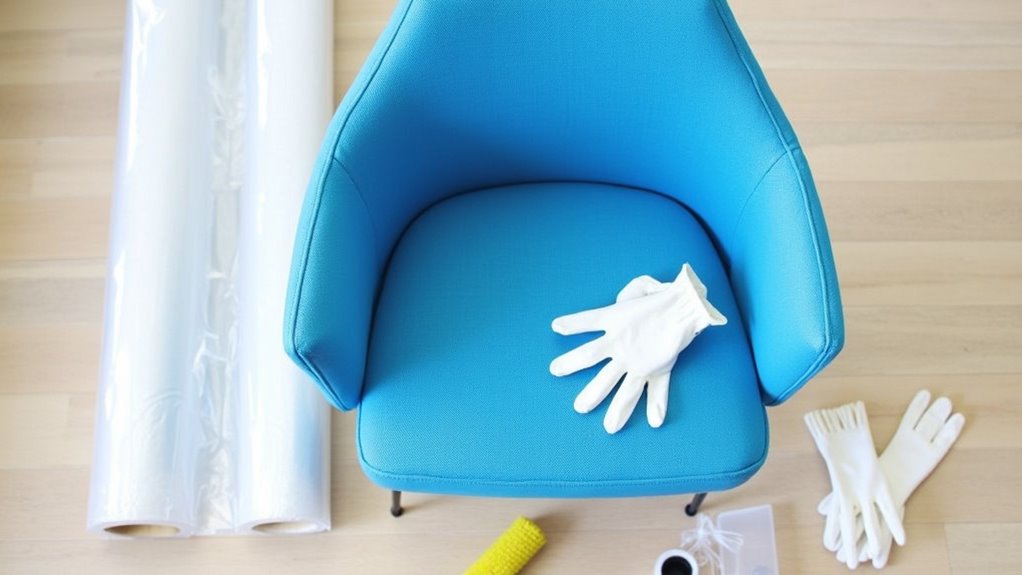
Tackling fiberglass requires some smart safety steps. Always wear protective gear. Use a P100-rated respirator mask, chemical-resistant gloves, and full-coverage goggles. Protect your skin and lungs!
Set up ventilation systems. Fans can help blow away fiberglass particles while you work. You want to keep the air clear.
After work, air dry any contaminated clothes outside. This keeps your home safe. Store dirty work clothes in sealed containers. No need to mix them with regular laundry.
Spilling ketchup is easy to clean. Remember, fiberglass is not! Use these tips to handle fiberglass safely and confidently.
Special Considerations for Furniture
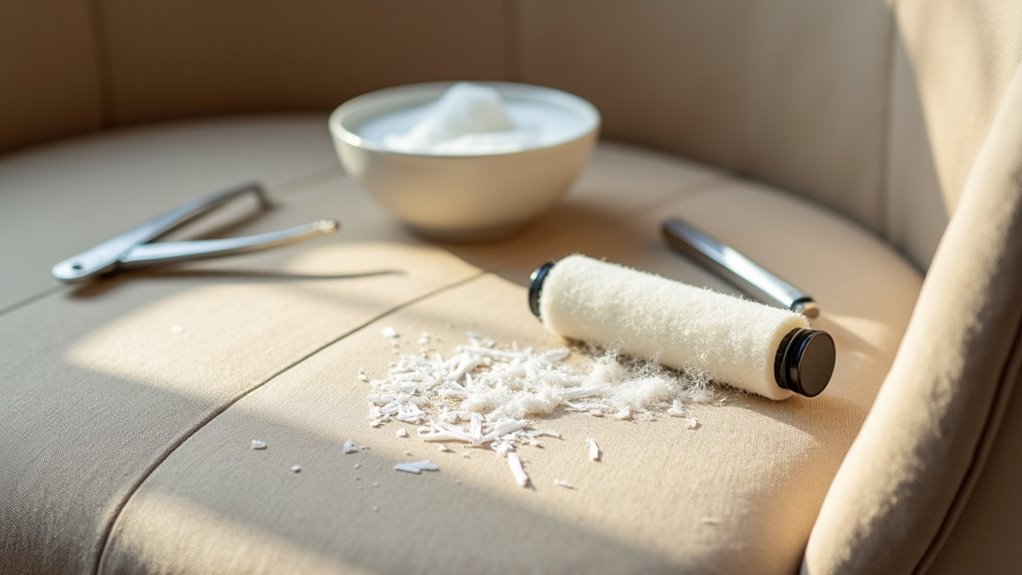
Cleaning fiberglass from furniture can seem tough, but it’s manageable! Follow these simple steps for a successful cleanup.
Start by isolating your chair. This keeps fiberglass from spreading to other furniture. Next, use drop cloths to cover nearby surfaces and floors. Protect yourself by wearing gloves and safety glasses. Mark the area clearly so others know to stay away.
Check every part of your chair with a bright flashlight. Look for shiny fiberglass strands tucked in the folds.
After cleaning, bag everything securely for disposal. Don’t forget to shower afterward to wash away any leftover particles.
With these steps, you’ll be a pro at removing fiberglass from furniture! Great job on keeping your space clean!
Frequently Asked Questions
Can I Use a Vacuum to Remove Fiberglass From a Chair?
You can use a vacuum to remove fiberglass from a chair. Make sure the vacuum has a HEPA filter. This filter traps tiny particles. It helps keep the air clean.
Wet cleaning can also help. Use a damp cloth to wipe the area. This method reduces airborne fibers. Always wear gloves and a mask. Protect yourself from irritation.
Take your time. Removing fiberglass safely is important. Clean the area thoroughly. Dispose of any fiberglass waste carefully.
What Are the Health Risks Associated With Fiberglass Exposure?
Fiberglass can cause health problems. Long exposure can irritate your lungs and skin. People often feel coughing or sneezing. Skin may itch or burn. Some may develop more serious issues over time. Watch for these signs. Protect yourself from dust and fibers. Wear masks and gloves when working with fiberglass. Keep your area clean to reduce risks. Stay informed about safety measures. Your health matters.
How Can I Identify Fiberglass in My Chair?
Identify fiberglass in your chair by checking for shiny, translucent threads. These threads may look like thin strands of glass. Run your fingers along the surface. A rough texture is a sign of fiberglass. Notice if the chair feels unusually stiff. Avoid touching it too much. Fiberglass can cause skin irritation. Always take care when inspecting.
Is It Safe to Use a Hairdryer for Fiberglass Removal?
Using a hairdryer to remove fiberglass is not safe. The heat can spread tiny fiberglass particles. This can increase the risk of breathing problems. Fiberglass is tricky to handle. It can irritate your skin and lungs.
Instead, consider safer methods for removal. Steam cleaning is one good option. It helps loosen the fiberglass without spreading it. Always wear protective gear, like gloves and masks. Your health is important. Choose safer ways to keep yourself safe from fiberglass.
Can Fiberglass Removal Damage the Upholstery Fabric?
Removing fiberglass can be tricky. One wrong move can hurt your upholstery. Fiberglass can make the fabric rough and stiff. This damages its look and comfort. Take your time and work carefully. Use protective gear like gloves and masks. Always test a small area first. This helps avoid big problems. If you need help, consider hiring a professional. They know how to do it safely. Keep your upholstery safe and looking good.
Conclusion
You’ve done a great job removing fiberglass from your fabric chair! Patience is key. Take your time, and don’t rush. With the right tools and steps, your chair will look new again.
First, wear gloves and a mask for safety. Use tape to lift fiberglass fibers gently. A lint roller can also help. Clean the area with a damp cloth afterward.
Next, check for any remaining fibers. Repeat the process if needed. Regularly vacuum the chair to keep it clean and safe.
This experience shows you can handle tough tasks. Keep up the good work on your DIY projects. You’ve got the skills!
